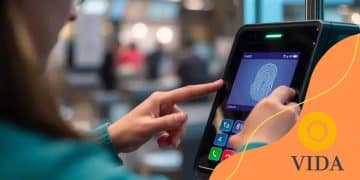Food benefit apps face cybersecurity scrutiny today

Food benefit apps face cybersecurity scrutiny due to their handling of sensitive user data, making it crucial for both users and providers to implement strong security measures and stay informed about potential vulnerabilities.
Food benefit apps face cybersecurity scrutiny, raising important questions about safety and privacy for users.
As these apps grow in popularity, it’s crucial to understand the associated risks and how they can be mitigated. Have you considered how these issues affect your experience with food benefit programs?
Understanding the cybersecurity risks in food benefit apps
Understanding the cybersecurity risks in food benefit apps is essential for both users and providers.
These apps allow individuals to access benefits conveniently, but they can also pose substantial security challenges.
Many food benefit apps collect sensitive data, such as personal identification information and financial records.
This makes them attractive targets for cybercriminals. In recent years, there have been numerous incidents where data breaches led to personal information being exposed.
Common Security Vulnerabilities
When using food benefit apps, it’s vital to be aware of common security vulnerabilities.
- Weak authentication methods: Some apps may use simple passwords, making them easier to hack.
- Unencrypted data transmission: Data that is not encrypted during transmission can be intercepted by malicious actors.
- Outdated software: Failing to update app software can leave users vulnerable to known exploits.
- Lack of security awareness: Users may not understand how to protect their information, exposing them to risks.
Furthermore, many users may overlook the importance of strong passwords or enabling two-factor authentication. A simple change, like using complex passwords, can greatly enhance security.
Mitigating Risks
To mitigate these risks, both users and providers need to adopt best practices. Users should regularly update their apps and ensure that their devices have up-to-date security settings.
Providers should invest in robust security measures, including regular security audits and user training on privacy practices.
By being proactive, both users and developers can help ensure that the advantages of food benefit apps are not overshadowed by potential risks. Being informed and vigilant can make a significant difference in the safety of using these applications.
Common vulnerabilities users should be aware of

Common vulnerabilities users should be aware of are critical for ensuring the safety of their personal information when using food benefit apps. Being informed about these vulnerabilities can help users protect their data effectively.
Many food benefit apps are prone to specific security issues. These issues can often be exploited by cybercriminals. Awareness is the first step in protecting oneself.
Key Vulnerabilities
Understanding specific vulnerabilities can help users take proactive measures. Here are some of the most common:
- Insufficient encryption: If sensitive data is not properly encrypted, it can be intercepted and misused.
- Insecure network connections: Using public Wi-Fi to access these apps may expose the data to hackers.
- Weak passwords: Simple, easily guessable passwords make it easier for attackers to gain unauthorized access.
- Outdated app versions: Failure to update apps can lead to ongoing vulnerabilities that have been patched in newer releases.
Avoiding public Wi-Fi can greatly reduce the risk of data interception while using food benefit apps. Additionally, regular updates to the app can fix potential security gaps.
Practical Steps for Users
For better security, users should always use strong, unique passwords and consider using password management tools.
Enabling multi-factor authentication can serve as an additional layer of security.
By staying informed about these vulnerabilities, users can make more educated choices and protect their sensitive information.
Taking these precautions can significantly reduce the risks associated with using food benefit applications.
Best practices for securing food benefit applications
Best practices for securing food benefit applications are vital for both users and developers. Implementing these strategies can significantly enhance the safety of sensitive information.
Many users aren’t fully aware of how to protect their information while using these apps. Fortunately, there are several steps you can take to improve security.
Key Security Measures
Ensuring your data is secure requires a few essential practices. Here are some important measures to consider:
- Use strong, unique passwords: Create complex passwords that are difficult for others to guess. Avoid using personal information.
- Enable two-factor authentication: This adds an extra layer of security beyond just your password.
- Update the app regularly: Make sure to download updates as they often include important security patches.
- Avoid public Wi-Fi: Using these networks can expose your information to potential hackers.
In addition to these measures, vigilance is crucial. Always check if the app uses encryption to safeguard your data.
When accessing your food benefit app, ensure that the URL starts with HTTPS.
Regular Security Check-ups
Users should routinely assess their app settings. Look for privacy options that limit data sharing and notifications about unusual account activity.
Staying informed about the app’s privacy policy can also help you understand how your information is used and protected.
By adopting these best practices, users can create a safer environment when using food benefit applications.
Taking proactive steps not only protects personal information but also enhances overall user experience.
How service providers can enhance cybersecurity
How service providers can enhance cybersecurity is crucial for maintaining user trust and protecting sensitive information.
With the rise in cyber threats, it’s important for providers to implement effective security measures.
Service providers have a key role in securing food benefit applications. By taking proactive steps, they can protect both their users and their systems from malicious attacks.
Essential Security Measures
Providers should focus on several key security measures. Implementing these can make a significant difference in overall app security.
- Regular security audits: Conducting thorough audits helps to identify vulnerabilities before they can be exploited.
- Data encryption: Encrypting sensitive data protects it during transmission and storage, making it unreadable to unauthorized parties.
- User education: Educating users about security best practices can empower them to protect their personal information.
- Incident response plans: Having a well-defined plan in place ensures quick action in the event of a security breach.
Additionally, it’s important for service providers to stay updated on the latest cybersecurity trends and threats. By continuously improving their security posture, they can better defend against evolving risks.
Collaboration with Experts
Partnering with cybersecurity experts can offer valuable insights and enhance security measures. Providers can benefit from external audits and recommendations tailored to their specific risks.
Involving cybersecurity professionals in the development phase can help identify potential flaws early on.
Integrating security from the beginning is far more effective than addressing issues after deployment.
By prioritizing these strategies, service providers can greatly enhance the cybersecurity of food benefit applications, ensuring a safer experience for all users.
The future of food benefit apps in a secure digital landscape
The future of food benefit apps in a secure digital landscape is promising, but challenges remain. As technology evolves, so does the need for better security practices.
These apps are becoming essential for users who rely on them for food assistance. However, the security of these applications must keep pace with technological advancements.
Emerging Technologies
New technologies are paving the way for enhanced security features. Some trends to watch include:
- Artificial Intelligence: AI can help detect fraudulent activities and identify security breaches in real-time.
- Blockchain technology: This allows for secure transaction records, ensuring transparency and trust among users.
- Biometric authentication: Features like facial recognition or fingerprint scanning add layers of security for user access.
Incorporating these innovations into food benefit apps can greatly improve their security. As a result, users will feel safer when accessing their benefits.
User-Centric Design
Designing apps with user security in mind is more important than ever. User-friendly interfaces that prioritize security features can help educate users on best practices.
By making security a focus, providers can build trust and encourage the adoption of these apps.
Moreover, regular updates to address new vulnerabilities will be crucial. Providers should also engage with users to gather feedback on security features and usability.
This ensures that app development remains aligned with user needs.
As we move forward, the integration of cutting-edge technology and a focus on user experience will shape the future of food benefit apps. By enhancing security, these applications can continue to provide vital assistance to those who need it most.
FAQ – Frequently Asked Questions about Food Benefit Apps and Cybersecurity
What are food benefit apps?
Food benefit apps are digital platforms that help users access food assistance programs and manage their benefits conveniently.
How can I ensure my information is safe when using these apps?
To keep your information safe, use strong passwords, enable two-factor authentication, and avoid using public Wi-Fi when accessing these apps.
What role do service providers play in cybersecurity?
Service providers must implement strong security measures like regular audits, data encryption, and user education to protect user information.
What technologies can enhance the security of food benefit apps?
Emerging technologies like artificial intelligence, blockchain, and biometric authentication can significantly enhance the security of food benefit applications.






